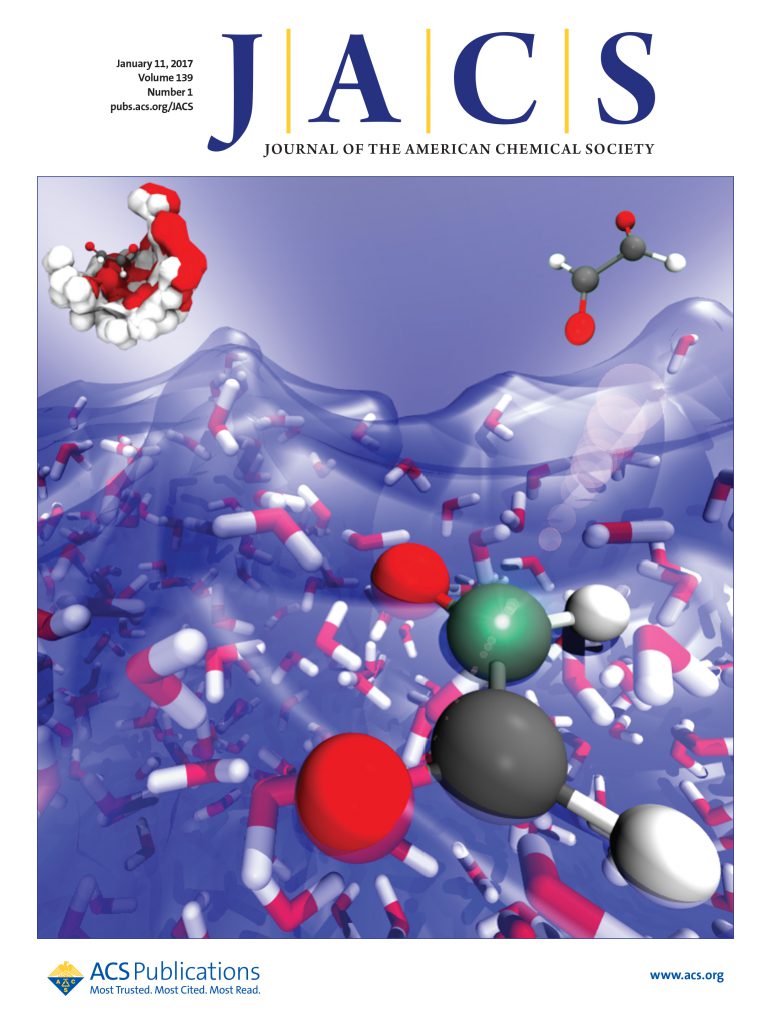NMR-Guided Studies to Establish the Binding Interaction between a Peptoid and Protein.
IF 14.4
1区 化学
Q1 CHEMISTRY, MULTIDISCIPLINARY
引用次数: 0
Abstract
Ligand discovery of nonenzymatic proteins can be accomplished through screening methods utilizing libraries comprising small molecules, peptides, and peptidomimetics. Incorporating peptoids, which are oligomers of N-substituted glycine monomers, into high-throughput screens can produce libraries of large structural diversity. Due to their malleable structures, peptoids can occupy unique protein binding sites, but determination of the peptoid binding pose is challenging. For example, the peptoid KDT-11 is reported to bind with low micromolar binding affinity to the proteasome subunit Rpn-13. Poor solubility of initial compound screening hits, like KDT-11, can greatly hinder progress in drug discovery since it limits in vitro characterization. The work reported here overcomes this hurdle with the addition of a solubility tag to KDT11, enabling elucidation of the biologically relevant surface of the peptoid through a variety of structure-activity relationships and biophysical studies. NMR paramagnetic relaxation data guided a structural modeling protocol using multiple molecular dynamics (MD) trajectories and extensive sampling. The final peptoid-protein structure is conformationally stable in equilibrium MD trajectories for >1 μs time period. KDT-11 binds across the β6/β7/β8 strands and α-helix of Rpn-13, revealing an interface for inhibition that could be targeted in future computational drug discovery efforts to obtain more potent ligands for Rpn-13. It is reasonable that the methodology described here can extend to other flexible peptoid or peptide ligands in complexes with proteins.核磁共振引导研究建立肽和蛋白质之间的结合相互作用。
非酶蛋白的配体发现可以通过利用包括小分子、多肽和拟肽物的文库的筛选方法来完成。将肽类(n -取代甘氨酸单体的低聚物)纳入高通量筛选中可以产生结构多样性大的文库。由于其具有延展性的结构,类肽可以占据独特的蛋白质结合位点,但确定类肽的结合姿势是具有挑战性的。例如,据报道,类肽KDT-11以低微摩尔结合亲和力与蛋白酶体亚基Rpn-13结合。初始化合物筛选点的溶解度较差,如KDT-11,可以极大地阻碍药物发现的进展,因为它限制了体外表征。本文报道的工作克服了这一障碍,在KDT11上添加了一个溶解度标签,通过各种结构-活性关系和生物物理研究阐明了肽类蛋白的生物学相关表面。核磁共振顺磁弛豫数据指导了使用多分子动力学(MD)轨迹和广泛采样的结构建模方案。最终的肽-蛋白结构在平衡MD轨迹中构象稳定,时间为>.1 μs。KDT-11通过Rpn-13的β6/β7/β8链和α-螺旋结合,揭示了一个抑制界面,可以在未来的计算药物发现工作中靶向获得更有效的Rpn-13配体。合理的是,这里描述的方法可以扩展到与蛋白质配合物的其他柔性肽或肽配体。
本文章由计算机程序翻译,如有差异,请以英文原文为准。
求助全文
约1分钟内获得全文
求助全文
来源期刊
CiteScore
24.40
自引率
6.00%
发文量
2398
审稿时长
1.6 months
期刊介绍:
The flagship journal of the American Chemical Society, known as the Journal of the American Chemical Society (JACS), has been a prestigious publication since its establishment in 1879. It holds a preeminent position in the field of chemistry and related interdisciplinary sciences. JACS is committed to disseminating cutting-edge research papers, covering a wide range of topics, and encompasses approximately 19,000 pages of Articles, Communications, and Perspectives annually. With a weekly publication frequency, JACS plays a vital role in advancing the field of chemistry by providing essential research.

 求助内容:
求助内容: 应助结果提醒方式:
应助结果提醒方式:


